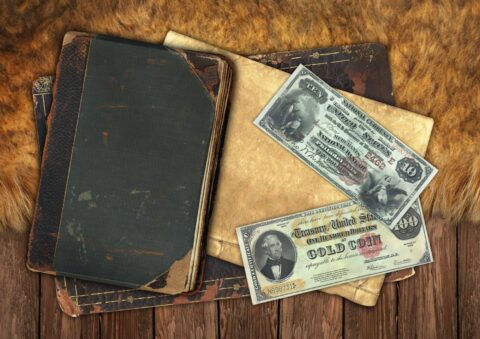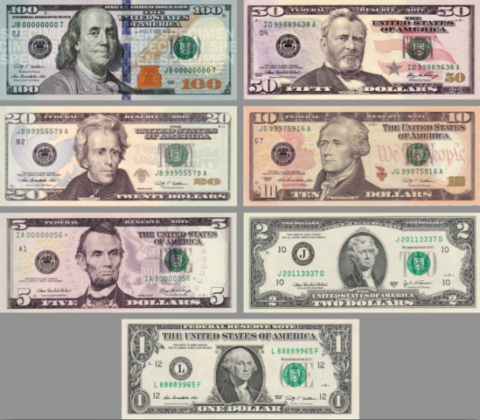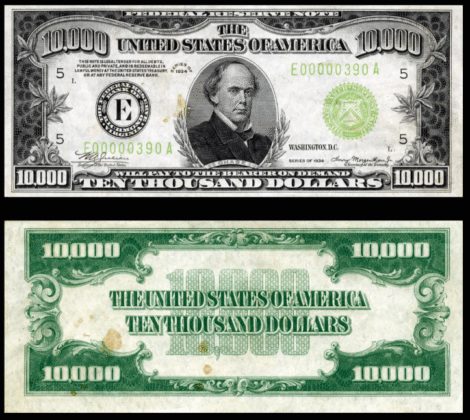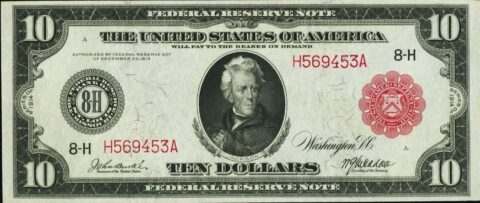
A lot of folks, myself included, have old U.S. paper money and want to know what it’s worth.
You’d be surprised what some paper currency is worth!
Sometimes, bills that are old and unusual are worth little over face value, while others that look ordinary are rare and valuable.
So, what is your U.S. paper currency worth?
Here are the answers you’ve been looking for…
What Are Those Letters On Paper Money?
The most common question people ask me about paper money has to do with those big letters on the fronts of our currency — you know, A, B, C, D, etc.
What do those letters on paper money mean?
The letter codes simply indicate which of the 12 U.S. Federal Reserve Banks printed a given note. They’re similar to mintmarks on coins.
Here’s a list of all the letter and number codes you’ll find on U.S. paper money:

- Boston A 1
- New York B 2
- Philadelphia C 3
- Cleveland D 4
- Richmond E 5
- Atlanta F 6
- Chicago G 7
- St. Louis H 8
- Minneapolis I 9
- Kansas City J 10
- Dallas K 11
- San Francisco L 12
Here are some more fun facts about paper money:
- Serial numbers contain 8 numerical digits. The 1st letter preceding the serial number corresponds to the Federal Reserve Bank branch that printed the bill (A = Boston, B = New York, and so on). The 2nd letter refers to the number of times that serial number has been used, with A representing the 1st time, B the 2nd, and so on.
- The series year isn’t necessarily when the bill was printed, but rather the last time there was a change either to the design of the bill or when a new Secretary of the Treasury has been appointed. A suffix letter is added at the end of the series year to indicate a new treasurer of the United States.
If you want to find out more about other details on U.S. paper money, I recommend you check out these helpful resources:
- Decoding A One Dollar Bill
- Fun Secrets To Look For On Dollar Bills
- How To Track The Dollar Bills You’ve Spent
U.S. Paper Money Values
Figuring out what paper money is worth isn’t always easy.
Knowing what your dollar bills and other paper currency are worth requires a basic working knowledge of the different types of U.S. currency and what collectors look for on their banknotes.
Here’s a rundown on the 2 major types of U.S. paper money:
- Large-size paper currency (issued before 1929) — These old bills measure 7.42″ by 3.125″ and are commonly dubbed “horseblankets” and “greenbacks.”
- Small-size paper currency (issued since Series 1928) — Modern-sized paper money measures 6.14″ wide by 2.61″ and is about 25% smaller than their large-size predecessors.
Then, there are the various categories of U.S. paper currency. They include:
- Silver Certificates — $1 to $1,000, issued from 1878 through 1964
- Gold Certificates — $10 to $10,000, issued from 1863 through 1933
- Confederate issues — Issued during the Civil War, which spanned from 1861 through 1865
- Federal Reserve Notes — $1 to $10,000, issued from Series 1914 to the present day
- Fractional currency, private-issue pieces, and other types of banknotes
The most widely collected U.S. paper money includes Gold Certificates, Silver Certificates, and Federal Reserve Notes. The values of these banknotes depends on their condition.
There are many, many banknotes that have been issued since the 19th century — far more than I could list in a single post here.
But I’d like to cover the pieces I’m most frequently asked about. What you’ll find below is a basic rundown on the values of various Silver Certificates, Gold Certificates, and Federal Reserve Notes.
Values Of Large-Size Paper Currency
- General large-size $1 bills pre-1929 — $50+ in worn condition
- General large-size $2 bills pre-1929 — $75+ in worn condition
- General large-size $5 bills pre-1929 — $60+ in worn condition
- General large-size $10 bills pre-1929 — $70+ in worn condition
- General large-size $20 bills pre-1929 — $75+ in worn condition
- General large-size $50 bills pre-1929 — $180+ in worn condition
- General large-size $100 bills pre-1929 — $400+ in worn condition
- General large-size $500 bills pre-1929 — $4,000+ in worn condition
- General large-size $1,000 bills pre-1929 — $5,000+ in worn condition
- General large-size $5,000 bills pre-1929 — Not Collectible
- General large-size $10,000 bills pre-1929 — Extremely Rare
Values Of Small-Size Silver Certificates

$1 Silver Certificates
- Series 1928 $1 bill — $20+ in worn condition
- Series 1934 $1 bill — $20+ in worn condition
- Series 1935 $1 bill — $3+ in worn condition
- Series 1957 $1 bill — $2+ in worn condition
$5 Silver Certificates
- Series 1934 $5 bill — $12+ in worn condition
- Series 1953 $5 bill — $10+ in worn condition
$10 Silver Certificates
- Series 1933 $10 bill — $5,200+ in worn condition
- Series 1934 $10 bill — $30+ in worn condition
- Series 1953 $10 bill — $50+ in worn condition
Values Of Small Size Gold Certificates
- Series 1928 $20 bill — $100+ in worn condition
- Series 1928 $50 bill — $250+ in worn condition
- Series 1928 $100 bill — $1,000+ in worn condition
- Series 1928 $500 bill — $2,500+ in worn condition
- Series 1928 $1,000 bill — $2,000 + in worn condition
- Series 1928 $5,000 bill — Very Rare
- Series 1928 $10,000 bill — Unknown Value
Values Of Modern Federal Reserve Notes Made Since The 1960s
Generally speaking, most modern-era Federal Reserve Notes (or paper currency made since the last silver certificates were issued in 1964) is worth very little over face value.
For example, worn examples of old dollar bills from Series 1969, Series 1974, or Series 1977 are worth $1.50 to $3.
While paper currency made before the current series has some collector value, it’s normally only a few bucks over face value, at best, if it’s worn.
Values for small-size paper currency made since the 1960s are generally more than face value if:
- The bill is uncirculated, or never used
- It has printing errors
- It contains fancy serial number combinations
- It carries other unusual features
What Is A $2 Bill Worth Today?
Many people think $2 bills are valuable.
That’s reasonable — because $2 bills don’t widely circulate, so they’re hardly seen by many people. It seems most people have never seen a $2 bill.
Believe it or not, most $2 bills that people encounter are common and, if they’re worn, are worth face value.
For example, Series 1976 $2 bills (the type of $2 bill most often encountered) is worth $2.
Other $2 bills — such as Series 1995, Atlanta Series 2003, Minneapolis Series 2009, and Series 2013 — are also worth face value if they’re worn.
UPDATE: Here’s how to tell if your $2 bills are valuable today, as described in this video:
What Are The Current Red Seal Values?

Many think that Red Seal and Star notes are worth more than face value. And they’re right.
But what are Red Seal notes anyway? Why did the United States print paper currency with red seals? Do seals come in other colors?
Here are some interesting facts about red seals and paper currency with seals of other colors:
- Red seals — Appear on legal tender notes from 1928 through 1966 and signify unbacked paper money
- Green seals — Seen on Federal Reserve Notes made since 1963 and indicate unbacked fiat money and are the only seal still seen on today’s paper money
- Blue seals — Printed on silver certificates from Series 1928 through Series 1957 and means the amount on the bill is payable in silver
Some Red Seal notes are quite valuable. Take, for example, the 1928 $1 Red Seal note, which is worth $200 and up in circulated condition.
Other worn Red Seals, such as the small-size Red Seal $5 bills from the 1920s through 1960s, are worth only $7 to $10.
A “Note” About Yellow Seals And Brown Seals
Yellow seals are found on some small banknotes and mean different things, including:
- Yellow seals on gold certificates issued from 1929 through 1933 indicated the bill was redeemable for gold coins up to the face value of the note.
- Yellow seals are also seen on emergency-issue silver certificates issued between 1942 and 1945 for use by United States military forces stationed in North Africa and Europe during World War II.
Yellow Seal $1 notes issued for World War II U.S. troops in North Africa are worth about $70 and up in circulated condition.
Meanwhile, brown seals:
- Are seen on small-size National Bank Notes from 1929 through 1935 issued as receipts for gold treasury bonds
- Appear on emergency Federal Reserve Banknotes issued during the Great Depression in 1933
- Can also be found on emergency Federal Reserve Banknotes printed from 1942 to 1945 for circulation in Hawaii to pay U.S. forces in the Pacific theater of World War II
Brown Seal notes are highly collectible. For example, Series 1935 Brown Seal $1 notes with “HAWAII” overprint are worth about $45 in circulated grades. While 1929 Brown $5 bills are worth about $60 in worn condition.
Values for Red Seal, Brown Seal, and emergency-issue Yellow Seal paper currency varies widely — so it’s important to look through a paper currency price guide or check with a paper currency dealer to get the specifics on your paper money.
Are Star Notes Worth Anything?… What Do They Even Mean?
Some collectors have asked me about star notes. What are they?
When inspectors at the U.S. Federal Bureau of Printing and Engraving find mistakes with certain pieces of money, they destroy the error notes and replace the notes with those of the same serial number but with an asterisk (*) after the serial number.
The addition of the asterisk, or star, ensures that no 2 pieces of paper currency of the denomination in the series have the same serial number. This also helps the government keep track of how many bills have actually been printed.
There’s some more info about star notes in this cool video:
So, what are star notes worth?
Given that only about 1% to 1.5% of paper currency consists of star notes, they’re relatively rare.
Even modern star notes are worth more than face value.
Consider, for the matter, worn Series 1981, 1985, 1988, and 1993 $1 star notes — they are worth $2.50 to $5 or more!
Older star notes are worth a little more money. For example, Series 1957 $1 Silver Certificate star notes are worth $4 to $7, and Series 1935 $1 star notes are worth about $10 and up in worn condition.
How Much Is Rare Confederate Money Worth?
A lot of people are curious about Confederate money, including:
- What Confederate money is worth
- How rare Confederate paper currency is
- Where to buy and sell Confederate paper money
Let’s start off by saying this… The vast majority of Confederate paper money people encounter is fake. Best estimates suggest only 3% of the Confederate money that people find is actually authentic.
Fake Confederate money is numismatically worth nothing.
It probably goes without saying at this point that Confederate bills (real Confederate paper money, that is) are quite scarce.
Perhaps surprising to some people, some Confederate paper money isn’t all that valuable. Some pieces are worth less than $100 in well worn condition, while others in nearly perfect condition go for thousands.
How much is your Confederate money worth? That depends on whether or not the name of a certain bank is stamped on the bill, the condition of the paper currency, its date, and other variables.
For this reason, it’s infeasible to provide a detail of Confederate money values here.
I would encourage you to submit an image of your Confederate currency to a paper money dealer or upload the photos to paper currency dealers online to get information about your specific bill.
What Are Fractional Notes?… Are They Valuable?

When the United States was experiencing the economically painful effects of the Civil War and coin shortages abounded, the government began issuing an array of paper currency with low face values under $1.
These so-called Fractional Notes (often called Shinplasters, because the paper was so cheap one could add starch and use the bills as paper mache shin warmers under socks) were issued from 1862 through 1876 in the following denominations:
- 3 Cents
- 5 Cents
- 10 Cents
- 15 Cents
- 25 Cents
- 50 Cents
These historic, often artful notes are widely collected by paper money enthusiasts.
Those who want to buy Fractional Notes can do so for a relatively affordable price, too. Some circulated specimens of some Fractional Notes can be bought for about $20 and up.




